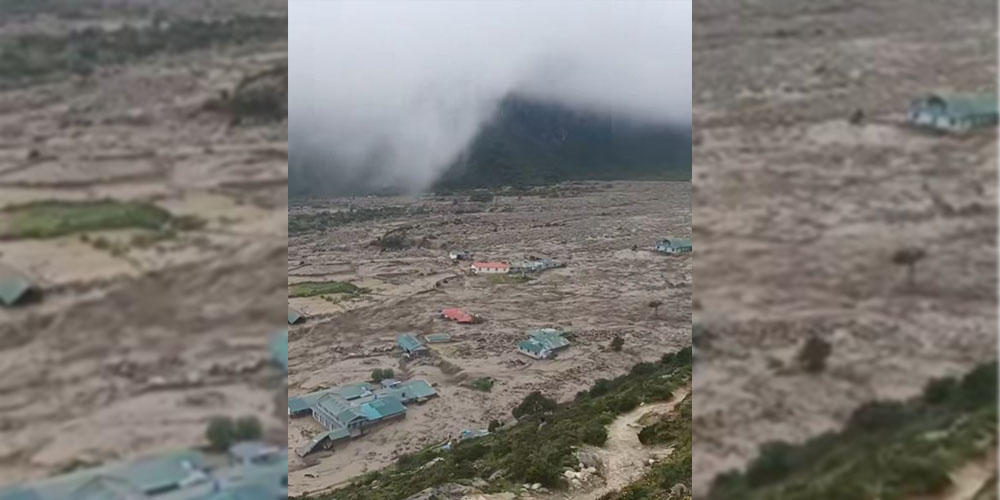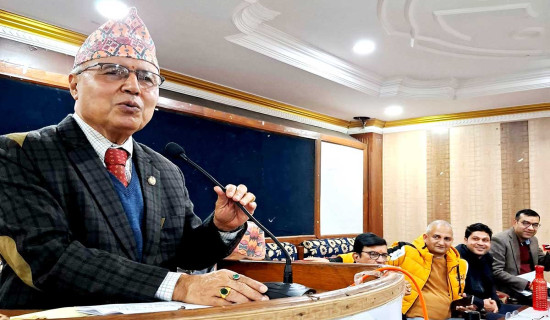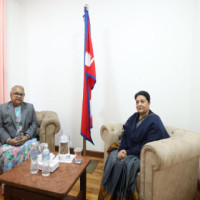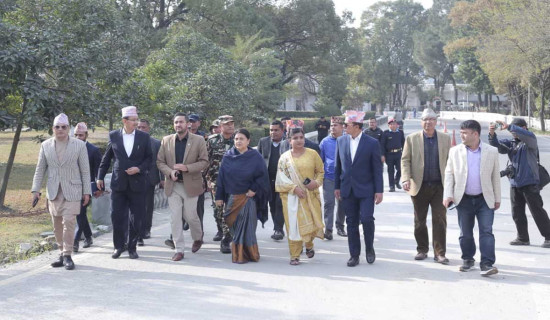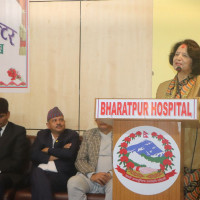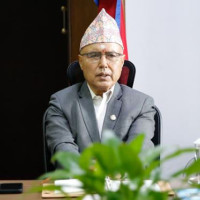- Monday, 8 December 2025
No resumption of communication in Thame village even five days after muddy flood
Kathmandu, Aug. 22: As of Wednesday, there has been no resumption of communication for the residents of Thame village in Khumbu Pasang Lhamu Rural Municipality.
The devastating flash flood and mudslide that struck Thame village in Khumbu Pasang Lhamu Rural Municipality-5 on August 16 (Friday) have left the area without telephone and electricity services.
The village was submerged by icy and muddy flood after a glacial lake burst its banks, displacing around 60 people and destroying over 20 houses and hotels, as well as a school and a health clinic.
Laxman Adhikari, Chairperson of Ward No. 4 of the rural municipality, who is currently in Kathmandu meeting with the Home Minister, said that they have lost contact with the entire village, making it very difficult to obtain the latest updates. The ongoing flow of mud and water destroyed three more houses on Tuesday.
“People in the area are living in fear as the floodwaters continue to come from upstream, and there are no communication services. We sometimes manage to connect, but the call disconnects after just a few words,” he said.
According to Adhikari, they are in the process to take relief materials by Wednesday night or by Thursday morning. “We are discussing at the ministry right now,” he said.
The lake, around 39,081.87 square metres in size and situated upstream of Thame village, was the source of the recent glacial lake outburst flood (GLOF) from the Thyanbo Glacier. This GLOF triggered flash floods and mudslides that devastated Thame village in the Sagarmatha region.
Reports indicate significant damage to homes, and infrastructure, including a school and clinic, but no casualties so far. Experts attribute the disaster to the sudden surge of the Bhotekoshi River, a Dudhkoshi River tributary, following the glacial lake breach.
On August 17, a team of experts conducted a ground inspection of the Thame area from a helicopter. Solukhumbu Chief District Officer Devi Pandey (Khatri) reported that the aerial inspection revealed the glacial lake upstream of Thame had burst, leading to the flood.
Talking to The Rising Nepal, Pandey said, “We do not have communication services. A team from the Nepal Army and Police is deployed there, but we have been unable to communicate with them. Relief materials packed since Tuesday have not been able to reach the area due to bad weather. The situation is woeful.”
“Reports indicate that the number of destroyed houses has increased to around 50, exceeding our earlier estimate of 20. The people of Thame village have been relocated to Upallo Thame with their relatives, and the floodwaters continue to flow,” Pandey added
What experts say
Arun Bhakta Shrestha, Senior Climate Change expert at the International Centre for Integrated Mountain Development (ICIMOD), said that after seeing the video footage, water from the upper lake appears to have overflowed into the lower lake, which has then burst and mixed into the Thame stream.
The lower lake is located at an altitude of around 4,760 metres above sea level, while the overflowed lake is at an altitude of 4,900 metres.
“We estimate that the upper lake may have only overflowed without actually bursting, as its physical structure does not appear to have been breached by the water. The surrounding rocks seem to be intact. In contrast, the lower lake appeared to be held back by a natural dam formed by sediment. After accumulating more water, its force breached this natural dam.” Shrestha said.
Dr. Sudeep Thakuri, a Climate Scientist said that while priority is currently given to large glacial lakes, smaller lakes are also increasing the risk. “There are lakes within the glacier ice as well, and these lakes have the potential to burst. Without proper study, it is not advisable to establish settlements around coastal areas, and existing settlements may need to be relocated,” he said.
The first step is research, after gathering accurate data, we can move forward with programs to reduce lake risks and relocate settlements. From east to west, the steep hills are prone to landslides, and rocks and boulders can fall at any time, putting glacial lakes at risk of bursting, Dr. Thakuri said.
Deepak KC, an expert on Climate Change and Resilience, at UNDP Nepal, highlighted that the recent disaster evoked memories of the GLOF from Dig Tsho (one of the tributary valleys of the Bhote Kosi Valley, above Thame Khumbu Himal) on August 4, 1985, devastatingly impacting lives, livelihoods, and infrastructure.
“Rising temperatures in the mountains are altering glacier and snow dynamics, leading to increased melting and instability. This instability, coupled with changes in rainfall, snowfall, and other meteorological patterns, heightens the risk of rock falls, landslides, and avalanches, which can trigger GLOFs and cause catastrophic breaches in glacial lakes,” KC said.
Current situation
A new report from ICIMOD and UNDP has identified 47 potentially dangerous glacial lakes (PDGLs) in Nepal, the Tibet Autonomous Region, and India. These lakes are at risk of causing glacial lake outburst floods (GLOFs), which are a major hazard in the Hindu Kush Himalaya. The report highlights 25 PDGLs in China, 21 in Nepal, and one in India.
Nepal suffers significant losses each year from extreme climate events, averaging 333 deaths and over USD 17.24 million in damages. Since 1977, Nepal has experienced 26 GLOF events, 14 of which originated in the country. With increasing glacial melt due to climate change, GLOFs continue to pose a serious threat. ICIMOD and its partners have been monitoring these risks since the early 2000s, building on a 2011 study, according to ICIMOD.

